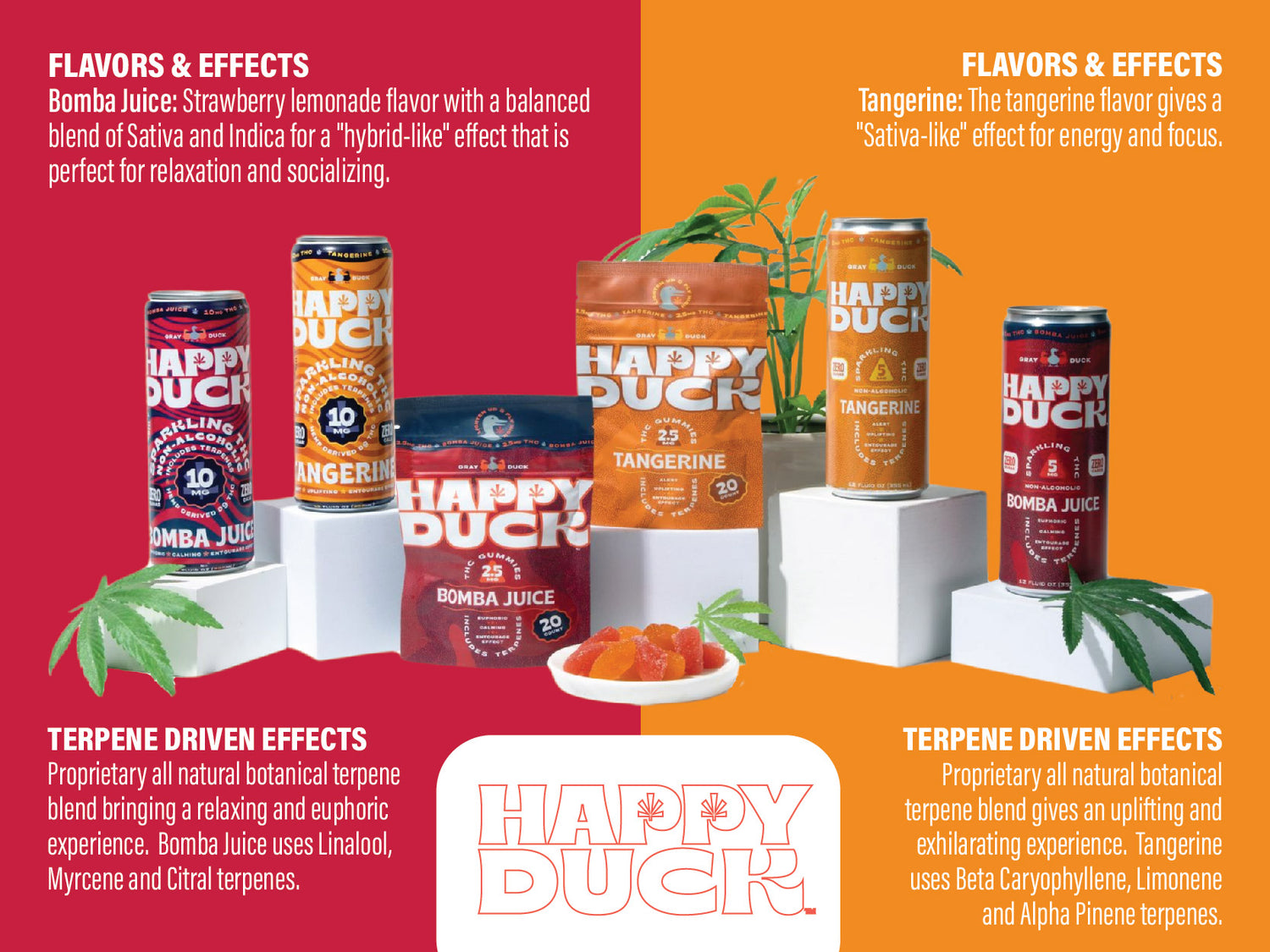
Happy Duck
Terpene Profiles & Effects
Happy Duck’s THC-infused beverage and gummy line features carefully selected terpenes that contribute to each flavor’s aroma and may influence the experience. Below is a breakdown of the key terpenes in each flavor – Bomba Juice and Tangerine – along with their scientifically studied effects and properties. Each terpene’s bullet points highlight its notable characteristics, supported by research.
Bomba Juice Terpenes
Linalool
Calming and Anxiolytic Effects: Linalool (prominent in lavender) is known for its calming, anxiety-reducing properties. Inhalation of linalool-rich lavender oil has been shown to decrease anxiety in animal studies, and clinical trials in humans reported reduced anxiety scores with linalool-containing aromatherapy leafly.com (Kasper et al., 2014). These findings suggest linalool can promote relaxation without intoxication.
Sedative and Analgesic Properties: Linalool exhibits sedative effects that may improve sleep quality. Research in mice demonstrated that inhaled linalool increased sleeping time and reduced movement, indicating significant sedative action (Linck et al., 2010). Additionally, linalool has pain-relieving potential – one study noted that post-surgery patients exposed to linalool (lavender oil) required less opioid analgesics, hinting at linalool’s analgesic benefits (Linck et al., 2010; Kasper et al., 2014).
Myrcene (β-Myrcene)
Sedation and Muscle Relaxation: Myrcene is a monoterpene famous for its sedative effects. At high doses in animal models, myrcene produces muscle relaxation and sedation comparable to barbiturate medications (Gurgel do Vale et al., 2002). This terpene is thought to contribute to the “couch-lock” effect in some cannabis strains, helping muscles relax and potentially aiding sleep (Gurgel do Vale et al., 2002; Russo, 2011).
Analgesic and Anti-Inflammatory Effects: Myrcene also displays noteworthy analgesic (pain-relieving) and anti-inflammatory properties. Preclinical studies have shown that myrcene can increase pain tolerance in mice, with effects similar to those of classic analgesics (Russo, 2011). In rodent experiments, myrcene blocked inflammatory hyperalgesia (heightened pain from inflammation) and its pain relief was partially reversed by an opioid blocker, suggesting an opioid-like mechanism (Russo, 2011). These findings support myrcene’s role in reducing pain and inflammation.
Citral
Sedative and Soothing Qualities: Citral, a lemon-scented terpene (actually a mix of the isomers geranial and neral), has demonstrated sedative and tranquilizing effects. Animal studies found that citral administration led to decreased locomotor activity and enhanced the duration of barbiturate-induced sleep, indicating strong sedative and motor relaxant properties (Gurgel do Vale et al., 2002). This suggests citral contributes to the soothing, mellow character of the Bomba Juice flavor.
Anti-Inflammatory and Analgesic Actions: Beyond its aroma, citral possesses anti-inflammatory and analgesic effects. Research in rodents showed that citral significantly reduced pain responses and inflammation – including decreased swelling and leukocyte migration in inflammatory models (Quintans-Júnior et al., 2011). In fact, citral’s pain-relieving efficacy in one study was comparable to morphine for certain types of pain stimulus (Quintans-Júnior et al., 2011). These properties make citral a promising component for calming discomfort and supporting a balanced inflammatory response.
Tangerine Terpenes
Beta Caryophyllene (β-Caryophyllene)
Anti-Inflammatory & Analgesic (CB₂ Activation): Beta-caryophyllene is a sesquiterpene with potent anti-inflammatory and pain-relieving properties. Uniquely, it binds selectively to cannabinoid CB₂ receptors in the body’s endocannabinoid system, acting as a non-psychoactive “phytocannabinoid” (Gertsch et al., 2008). Through CB₂ activation, β-caryophyllene has been shown to reduce inflammation and pain in numerous preclinical models (Gertsch et al., 2008; Klauke et al., 2014). This means Tangerine’s beta-caryophyllene may help alleviate inflammatory discomfort and contribute to overall soothing effects.
Anxiolytic and Mood-Modulating Effects: Studies also indicate that β-caryophyllene can produce anxiety-reducing and antidepressant-like effects. In mice, oral β-caryophyllene elicited behaviors consistent with reduced anxiety and depression, an effect found to be mediated by CB₂ receptors (Bahi et al., 2014). These findings suggest that beta-caryophyllene might promote a calm mood and stress relief, aligning with the relaxing vibe of the Tangerine flavor.
Limonene
Elevated Mood and Stress Relief: Limonene is a citrus-scented monoterpene known for its uplifting, mood-enhancing qualities. Scientific studies have observed that inhalation or administration of limonene produces anti-anxiety effects in animals – for example, mice exposed to limonene showed less anxiety-like behavior in maze tests (Lima et al., 2013). The mechanism appears to involve neurotransmitter modulation: one study found limonene’s anxiolytic effect is linked to activating adenosine A₂A receptors, which regulate dopamine and GABA in the brain (Song et al., 2021). For consumers, this translates to potential stress relief and a brighter mood associated with Tangerine’s limonene content.
Anti-Inflammatory and Antioxidant Properties: Limonene also exhibits anti-inflammatory and antioxidant effects that can contribute to wellness. Research in a rat model of ulcerative colitis demonstrated that D-limonene supplementation significantly reduced inflammation and oxidative stress in the gut (Yu et al., 2017). Additionally, limonene has been noted to support immune function and even showed potential in alleviating asthma/allergy symptoms in preclinical studies (Yu et al., 2017). Thus, limonene not only adds a zesty aroma but may also help modulate inflammation and protect cells from oxidative damage.
Alpha-Pinene (α-Pinene)
Anti-Inflammatory and Bronchodilatory Effects: Alpha-pinene, a major component of pine resin, has well-documented anti-inflammatory activity and can act as a bronchodilator. In human volunteer studies, even low exposure to α-pinene was found to widen airways, supporting easier breathing (Falk et al., 1990). This terpene has also been implicated in reducing inflammatory reactions in respiratory conditions; its presence in forest environments is thought to contribute to the anti-inflammatory benefits of “forest bathing” (Kim et al., 2020). In the Tangerine flavor, alpha-pinene’s presence may promote a soothing effect on the respiratory system and help counteract irritation.
Memory and Alertness Support: α-Pinene is unique among terpenes for its potential nootropic benefits. It inhibits acetylcholinesterase, the enzyme that breaks down the neurotransmitter acetylcholine, which is crucial for memory and cognition (Russo, 2011). By preventing acetylcholine breakdown, alpha-pinene may aid memory retention and alertness (Russo, 2011). Some researchers have even suggested this property could counteract the short-term memory deficits occasionally associated with THC, helping users stay clear-headed. In essence, alpha-pinene adds a crisp pine aroma to Tangerine while contributing to mental clarity.
